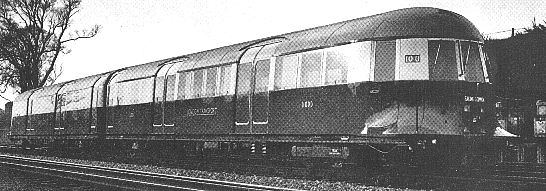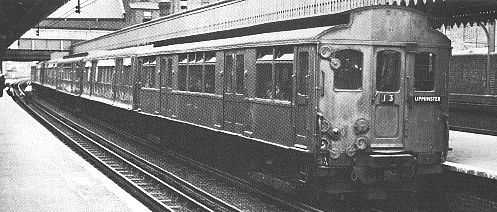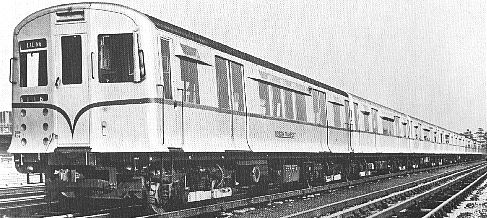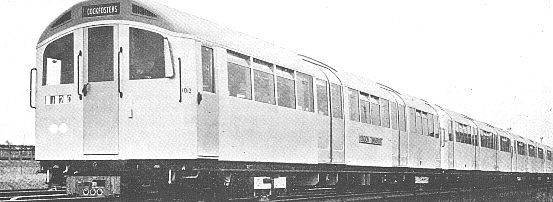
Suburban Electric Railway Association
Located at the COVENTRY ELECTRIC RAILWAY CENTRE, Rowley Road, Baginton, Warwickshire
Established
1996
The History Zone
Electrifying London
New Works Rolling Stock
The period from 1935 is when EMU design in the UK came of age. The London Underground were at the forefront of this age of progression and designed units that set the standards which were benchmarks for the next 30 years. One man can claim responsibility for the, the Undergrounds CME Mr. W.S.Graff-Baker who took over the post in 1934. These are the trains that came into being during and immediately after his reign.
1935 Experimental Tube Stock
With the announcement of the New Works programme came the need to provide modern efficient units to provide the more demanding service. Graff-Bakers team set about designing the new age tube train and set themselves the target of improving a number of key areas. Firstly the equipment had to be mounted under the floor so as to leave all available space in the car bodies except for the driving cabs available for passenger seating. Secondly the traction motors would be smaller and more evenly distributed along the train length to make for better acceleration and Thirdly the electrical equipment must be the most modern and efficient then available.
To put possible solutions to these demands into practice 12 two car units (marshalled into 4 six car trains) were built in 1935 each featuring different equipments from various manufacturers. The first nine units were built with a streamlined cab end with a view to achieving higher speeds whilst the final three units had a flatter front end. All units featured under floor equipment and as a result a six car unit had the same seating capacity as a seven car train of 'Standard' stock.

Above: A streamlined unit of 1935 experimental tube stock with the flat front type below

All units were extensively trialed with the flat front style of body decided upon as the best design with the equipment supplied by Crompton Parkinson decreed as the standard for the production trains. All the streamlined units were stored during the second world war and when hostilities ceased they were all converted to tailer cars to insert in 1938 tube stock units. The flat fronted units lasted a number of years on odd duties.
1938 Tube Stock
These units were the production stock built as a result of the experimental stock mentioned above and were nearly identical to the flat front design of the last three units. The type went on to become the most numerous and widely traveled tube trains ever built. The units were built in 4 and 3 car sets, a four car was formed of a driving motor at each end which had a driving cab and two motored axles with an un-powered trailer and a non-driving motor (NDM) coach in between, the NDM had two powered axles like the driving motors but had no driving controls. The compressors were fitted to the trailer and NDM coaches and motor generator sets to the driving motors. Three car units had the same vehicles except for the NDM which was omitted from the formation.
After initial teething problems which did not get ironed out until after the war the 38 stock settled down to provide the back bone of tube services. During their life span they worked on the Bakerloo, Northern, Piccadilly and East London Line and also on parts of the Central line. Withdrawals started in the 1970s but the type was found to to indispensable and the last sets remained in service up until 1986.
Eighteen of the driving motor coaches have found a new lease of life on the Island Line service between Ryde and Shanklin on the Isle Of Wight.
O and P Stock
Both the Metropolitan and Hammersmith & City lines were in need of new stock in the mid 1930s. So the opportunity was taken to push the available technology to the limits and produce a train that was fitting of the age. The result was the O and P stock types.
Both types were virtually identical with open saloon layout of each of their two driving motor coaches that initially made up each unit. A middle vehicle was added after a while to make them up to three car sets and this was a trailer car with driving motor vehicles either side of it. The most distinctive feature of the stock was the flared skirt on the lower bodyside which eliminated door foot steps and thus the possibility of late passengers trying to board a moving train. The interiors featured forced air ventilation. One of the major differences between O and P stock was that the guards door operation position was provided in the driving cab on the former but on the latter was found at the inner end of one of the motor coaches.
The traction control apparatus featured a device known as a Metadyne machine which accelerated the motors of the train under the drivers control but without the need for traction resistances as had been the case on all previous stock. This development went on to prove troublesome in service and was removed in the mid 1950 when the trains were converted to standard camshaft and resistance control equipment that had proved successful on the 1938 stock.
The units were first used on the Hammersmith & City and Uxbridge and Watford sections of the Metropolitan Line but during the course of their lives they also saw service on the District and Circle lines as well. The last sets ran in passenger service in March 1981.
District Line Q Stock Programme
The Q stock programme started in 1938 and was devised to modernise the District Line fleet that comprised of many different types of vehicles of varying vintages. The idea being to eliminate the oldest stock on the line and bring all stock built from 1923 onward up to more modern standard. The Q stock programme involved very little new building of vehicles at all compared to the number of existing cars that were to be upgraded.
The reclassifying of units involved fitting them with air operated sling doors with passenger door control, electro pneumatic brakes with retardation control and making all stock fully compatible. In order to be able to dispose of all the pre 1920 built stock 25 new driving motor and 183 new trailer cars were built and these featured identical body shells as used on the O and P stock.

Above: A Q stock train with an assortment of vehicles in it's consist in the early 50's
Even after the programme was complete it was still possible to see Q stock trains running on the District Line with vehicles of no fewer than six different types in their formation. The last Q stock ran (on the East London Line) in 1971.
R Stock
After the Second World War ended the district drew up plans to replace the large number of older units that still operated on the Circle Line and to replace District Line vehicles destroyed by enemy action during the war. The R stock used the same internal and external arrangement as the O and P stock but their the similarities ended. All vehicles in the units were motor coaches, one axle on each bogie being motorised. The trains were built as six and two car sets, the former had a driving cab on each outer end but the two cars only had the cab at one end as they were required to be detached during off peak periods when passenger loadings were lower. All but six of the driving motor cars of the first batch of R stock which was delivered in 1949 (but refered to as R47 stock) were converted from 1938 built Q stock motor coaches. All R stock featured similar internal layout to O and P stock but with fluorescent lighting.

The second batch of R stock cars delivered in 1952 (know as R49 stock) featured a new development in EMU construction in the use of aluminium alloy for the body and frame work of the vehicles. Some non driving and driving motor coaches of this second batch were converted from 1938 Q stock cars. During the delivery of this batch an experiment was carried out in leaving one new build car unpainted so that it ran in it's bare aluminium finish rather than LT train red. It was found that difficulties arose with this and it was decided to form a complete eight car formation of unpainted cars. In due course this became the preferred livery for all new LT trains from the 1950s onward; the classic underground silver train look was thus created. A third and final batch of R stock was built in 1959 (R59 stock). As the converted Q stock cars were originally built of steel it was necessary to paint them in an aluminium finnish to match the unpainted exterior of the new build R stock cars.
During 1971 the R stock were reformed into seven coach trains and the detaching of the two car sets during off peak periods ceased. The last R stock ran in service in 1983.
1956/59/62 Tube Stock
In order to cope with a build up of traffic on the Central and Piccadilly lines new stock was required to replace the last of the 'Standard' stock still in use on these lines in the 1950s. In order to evaluate different ideas for the new builds three seven car trains were ordered, one from each of the main builders of the time; Met-Cam, BRC&W and Gloucester RC&W. The trains were made up of a three and a four car unit as per the 1938 stock. All of the trains were roughly identical with differences only in their electrical equipment. The internal layout was exactly that of the 1938 stock and the external layout differed from that stock only in respect of a more flat front and the use of aluminium alloy for the body skin, which was left unpainted as per the R49 stock. The main internal difference from the 1938 stock was the use of fluorescent strip lighting. The first use of rubber suspension was made on these trains which was incorporated into all subsequent designs. It was fair to say that the 1956 stock experimental trains were simply an advancement of the 1938 stock design.
The first production units built as a result of the 1956 stock trials began delivery in 1959 for use on the Piccadilly Line, these units were to all intents and purposes clones of the 1956 stock trains and were built by Met-Cam in three and four car units. The 1959 stock was transferred to the Northern Line from 1975.

Above: A brand new 1959 stock unit
The 1962 stock was built only in four car units by Met-Cam with BR Derby works building all the trailer cars. There were only slight detail differences between the 1959 and 1962 stock and the two were fully compatible. The first units arrived on the Central Line in early 1962 and their delivery enabled 'on loan' units of 1959 stock to be returned to the Piccadilly Line. The 1962 stock continued to work the Central Line until 1993 when they were displaced by new stock. Some have subsequently been reallocated to the Northern Line.
